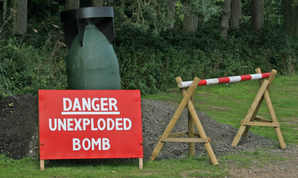|
In late 1939 the Royal Navy Bomb Disposal Teams were set up under the Directorate of Naval Ordnance under the Director of the Naval Unexploded Bomb Department (DUBD) to discharge the Royal Navy’s responsibility for dealing with unexploded bombs on its own property.
By 20 September 1940 there were Naval bomb disposal teams at 27 shore establishments. Each team was led by a BSO (Bomb Safety Officer) who was normally a Sub Lieutenant RNVR or Commonwealth equivalent of the RNVR. |
|
Clearance Diving takes its name from the operations carried out towards the end and after the Second World War to clear the ports and harbours of the Mediterranean and Northern Europe of unexploded ordnance and booby traps laid by the Germans. This work was undertaken by RN Rendering Mines Safe (RMS) and Bomb Disposal Units and later by Port Clearance Parties or ‘P’ Parties, two of which (Naval Parties 1571 and 1572) went into action soon after D-Day to clear the vast quantities of unexploded ordnance and general debris left after the Allied invasion. They were joined later by other ‘P’ Parties including ‘P’ Parties 1573, 1574, 1575 and 2444 (many of which had Commonwealth naval personnel) and ‘P’ Party 3006 manned by the Dutch. Work in the European theatre continued until well after the end of the war. Most of the ‘P’ Parties were disbanded, together with HMS Vernon(D) at Brixham, on 30 November 1945. The exceptions were ‘P’ Party 2444, which was still operating at Dunkirk, and ‘P’ Party 2443 which had been formed in June 1945 to deal with residual suspected unexploded ordnance around the UK coast after the war and became based at HMS Vernon, Portsmouth.
|
|
In 1950, a Home Station Clearance Diving Team was set up and other Clearance Diving Teams were soon established to support the Mediterranean Fleet and the Far East Fleet. In 1951, clearance diving training moved from Lochinvar to Vernon and a new Clearance Diving School was established combining the training of clearance divers with that of ‘deep’ divers.
This school also took on the new task of training Ships’ Divers so that every ship had a properly equipped air diving capability under its own Diving Officer to conduct ship’s bottom searches and undertake simple underwater engineering tasks. |






